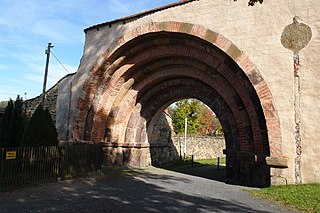
Ballenstedt is a town in the Harz district, in the German state of Saxony-Anhalt.

Harzgerode is a town in the district of Harz in Saxony-Anhalt, Germany.

Lorsch Abbey, otherwise the Imperial Abbey of Lorsch, is a former Imperial abbey in Lorsch, Germany, about 10 km (6.2 mi) east of Worms. It was one of the most important monasteries of the Carolingian Empire. Even in its ruined state, its remains are among the most important pre-Romanesque–Carolingian style buildings in Germany.

Gröningen Priory was a Benedictine monastery, located west of Gröningen in present-day Saxony-Anhalt, Germany. The abbey church is part of the Romanesque Road scenic route.

Reinhardsbrunn in Friedrichroda near Gotha, in the German state of Thuringia, is the site of a formerly prominent Benedictine abbey, the house monastery of the Ludovingian Landgraves of Thuringia abbey extant between 1085 and 1525. Later used as an administrative seat by the Ernestine dukes of Saxony, the property was turned into a castle and park erected by the Dukes of Saxe-Coburg and Gotha from 1827.

Tegernsee Abbey is a former Benedictine monastery in the town and district of Tegernsee in Bavaria. Both the abbey and the town that grew up around it are named after the Tegernsee, the lake on the shores of which they are located. The name is from the Old High German tegarin seo, meaning great lake.

Prüfening Abbey was a Benedictine monastery on the outskirts of Regensburg in Bavaria, Germany. Since the beginning of the 19th century it has also been known as Prüfening Castle. Notably, its extant dedicatory inscription, commemorating the founding of the abbey in 1119, was created by printing and is a unique document of medieval typography.

Wechselburg Priory, formerly Wechselburg Abbey is a Benedictine priory in Wechselburg in Saxony, dissolved in the 16th century and re-founded in 1993.

Nienburg is a town in the district of Salzlandkreis in Saxony-Anhalt, Germany. It is located in the lower Saale valley, approx. 5 km northeast of Bernburg. In January 2010 it absorbed the former municipalities Gerbitz, Latdorf, Neugattersleben, Pobzig and Wedlitz, that became Ortschaften or municipal divisions of the town. In 2020 its population was 6,104.

Saint Paul's Abbey in Lavanttal is a Benedictine monastery established in 1091 near the present-day market town of Sankt Paul im Lavanttal in the Austrian state of Carinthia. The premises centered on the Romanesque monastery church were largely rebuilt in a Baroque style in the 17th century.

Ellwangen Abbey was the earliest Benedictine monastery established in the Duchy of Swabia, at the present-day town of Ellwangen an der Jagst, Baden-Württemberg, about 100 km (60 mi) north-east of Stuttgart.

St. Mang's Abbey, Füssen or Füssen Abbey was a Benedictine monastery in Füssen in Bavaria, Germany. It was founded in the 9th century, and dissolved during the post-Napoleonic secularisation of Bavaria.

Memleben Abbey was a Benedictine monastery in Memleben on the Unstrut river, today part of the Kaiserpfalz municipality in Saxony-Anhalt, Germany. The convent, now ruined, was established by Emperor Otto II and his consort Theophanu about 979.

Marchtal Abbey is a former Premonstratensian monastery in Obermarchtal in the Alb-Donau-Kreis, Baden-Württemberg, Germany. The minster church of Saints Peter and Paul, the former abbey church, located on a prominent elevation, still dominates the landscape for miles around.
Michaelstein Abbey is a former Cistercian monastery, now the home of the Stiftung Kloster Michaelstein - Musikinstitut für Aufführungspraxis, near the town of Blankenburg in the Harz in Sachsen-Anhalt, Germany.

Drübeck Abbey is a former Benedictine monastery for nuns in Drübeck on the northern edge of the Harz in the German state of Saxony-Anhalt. Today it is a conference venue for the Evangelical Church of the Church Province of Saxony with an educational-theological institute and pastoral centre.

Altzella Abbey, also Altzelle Abbey, is a former Cistercian monastery near Nossen in Saxony, Germany. The former abbey contains the tombs of the Wettin margraves of Meissen from 1190 to 1381.

Saint Cyriakus is a medieval church in Gernrode, Saxony-Anhalt, Germany. It is one of the few surviving examples of Ottonian architecture, built in 959/960–965 by Margrave Gero, although it was restored in the 19th century. From its foundation until 1614, Saint Cyriakus was the collegiate church of the Abbey of Gernrode, also founded by Margrave Gero. The church and the abbey became Protestant in the mid-sixteenth century, and the church is now used by the Protestant community of Gernrode.

Arnoldstein Abbey was a Benedictine abbey in Arnoldstein in Carinthia, Austria. Its church was dedicated to St George and first mentioned in historical records in 1316 - its choir, tower, west door and a few buttresses can still be seen. The monastery buildings from the Gothic and 17th century eras were arranged around the church in an oval.



















